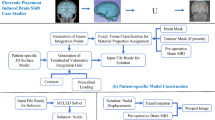Abstract
This paper addresses estimation of brain deformation during craniotomy using finite element modeling. Two mechanical models are optimized and compared for this purpose: linear solid-mechanic model and linear elastic model. Both models assume the realistic finite deformation of the brain after opening the skull. In this study, we use pre-operative and intra-operative magnetic resonance images (MRI) of five patients undergoing brain tumor surgery. Anatomical landmarks are identified by an expert radiologist on MRI and used for the method development and comparison studies. We use tetrahedral finite element meshes and optimize model parameters by minimizing the mean distance between the predicted locations of the anatomical landmarks using the pre-operative images and their actual locations on the intra-operative images. Evaluation of the objective function using a second set of landmarks not used in the optimization process suggests that accuracy of the solid mechanic model is higher than that of the elastic model for our application. Visual inspection of the results confirms this conclusion. The proposed method along with the location information of the surface landmarks measured in the operating room and marked on the pre-operative images can be used to estimate the brain deformations without needing intra-operative images. In this case, since the parameters of the brain tissue are not the same for different patients, the proposed optimization process is crucial for obtaining accurate results.






Similar content being viewed by others
References
Wittek, A., Miller, K., Laporte, J., Kikinis, R., & Warfield, S. (2004). Computing reaction forces on surgical tools for robotic neurosurgery and surgical simulation. Canberra: CD Proceedings of Australasian Conference on Robotics and Automation ACRA.
Miller, K. (2005). Method of testing very soft biological tissues in compression. Journal of Biomechanics, 38, 153–158.
Miga, M. I., Paulsen, K. D., Hoopes, P. J., Kennedy, F. E., Hartov, J. A., & Roberts, D. W. (2000). In Vivo quantification of a homogeneous brain deformation model for updating preoperative images during surgery. IEEE Transactions on Biomedical Engineering, 47, 266–273 Feb.
Dumpuri, P., Thompson, R. C., Dawant, B. M., Cao, A., & Miga, M. I. (2007). An atlas-based method to compensate for brain shift: Preliminary results. Medical Image Analysis, 11, 128–145.
Platenik, L. A., Miga, M. I., Roberts, D. W., Lunn, K. E., Kennedy, F. E., Hartov, A., et al. (2002). In vivo quantification of retraction deformation modeling for updated image-guidance during neurosurgery. IEEE Transactions on Biomedical Engineering, 49, 823–835 Aug.
Clatz, O., Delingette, H., Talos, I. F., Golby, A. J., Kikinis, R., Jolesz, F. A., et al. (2005). Robust nonrigid registration to capture brain shift from intraoperative MRI. IEEE Transactions on Medical Imaging, 24, 1417–1427 Nov.
Paulsen, K. D., Miga, M. I., Kennedy, F. E., Hoopes, P. J., Hartov, A., & Roberts, D. W. (1999). A computational model for tracking subsurface tissue deformation during stereotactic neurosurgery. IEEE Transactions on Biomedical Engineering, 46, 213–225 Feb.
Paulsen, K. D., Miga, M. I., Roberts, D. W., Kennedy, F. E., Platenik, L. A., Lunn, K. E., et al. (2001). Finite element modeling of tissue retraction and resection for preoperative neuroimage compension with surgery. Medical Imaging 2001: Visualization, Display, and Image-guided Procedures, 2, 13–21.
Miga, M. I., Sinha, T. K., Cash, D. M., Galloway, R. L., & Weil, R. J. (2003). Cortical surface registration for image-guided neurosurgery using laser-range scanning. IEEE Transactions on Medical Imaging, 22, 973–985 Aug.
Ferrant, M., Nabavi, A., Macq, B., Black, P. M., Jolesz, F. A., Kikinis, R., et al. (2002). Serial registration of intraoperative MR images of the brain. Medical Image Analysis, 6, 337–359.
Ferrant, M., Nabavi, A., Macq, B., Jolesz, F. A., Kikinis, R., & Warfield, S. K. (2001). Registration of 3-D intraoperative MR images of the brain using a finite element biomechanical model. IEEE Transactions on Medical Imaging, 20, 1384–1397.
Bathe, K. J. (1996). Finite element procedures. Englewood Cliffs: Prentice Hall.
Wittek, A., Miller, K., Kikinis, R., & Warfield, S. K. Patient-specific model of brain deformation: Application to medical image registration. Journal of Biomechanics, in press, Accepted 27 February 2006.
Wittek, A., Kikinis, R., Warfield, S. K., & Miller, K. (2005). Computation using a fully nonlinear biomechanical model. Proceedings of MICCAI 2005, LNCS (vol. 3750, pp. 583–590). Heidelberg: Springer.
Miga, M. I., Paulsen, K. D., Lemery, J. M., Eisner, S. D., Hartov, A., Kennedy, F. E., et al. (1999). Model-updated image guidance: Initial clinical experiences with gravity-induced brain deformation. IEEE Transactions on Medical Imaging, 18, 866–874 Oct.
Lunn, K. E., Paulsen, K. D., Liu, F., Kennedy, F. E., Hartov, A., & Roberts, D. W. (2006). Data-guided brain deformation modeling: evaluation of a 3-D adjoint inversion method in porcine studies. IEEE Transactions on Biomedical Engineering, 53(10), 1893–1900 Oct.
Acknowledgement
Patient-specific geometric data for the brain were obtained from pre- and intra-operative MRI studies of patients undergoing brain tumor surgery at the Surgical Planning Laboratory, Brigham and Women’s Hospital, Harvard Medical School, Boston, MA, USA. The authors gratefully acknowledge and thank Prof. Ron Kikinis and Dr. Tina Kapur for providing this crucial data.
Author information
Authors and Affiliations
Corresponding author
Rights and permissions
About this article
Cite this article
Hamidian, H., Soltanian-Zadeh, H., Faraji-Dana, R. et al. Estimating Brain Deformation During Surgery Using Finite Element Method: Optimization and Comparison of Two Linear Models. J Sign Process Syst Sign Image Video Technol 55, 157–167 (2009). https://doi.org/10.1007/s11265-008-0195-5
Received:
Revised:
Accepted:
Published:
Issue Date:
DOI: https://doi.org/10.1007/s11265-008-0195-5




